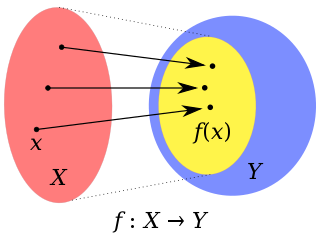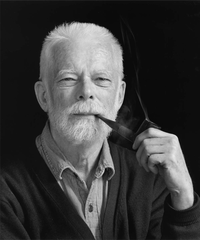Noncommutative geometry (NCG) is a branch of mathematics concerned with a geometric approach to noncommutative algebras, and with the construction of spaces that are locally presented by noncommutative algebras of functions. A noncommutative algebra is an associative algebra in which the multiplication is not commutative, that is, for which does not always equal ; or more generally an algebraic structure in which one of the principal binary operations is not commutative; one also allows additional structures, e.g. topology or norm, to be possibly carried by the noncommutative algebra of functions.
In functional analysis, an operator algebra is an algebra of continuous linear operators on a topological vector space with the multiplication given by the composition of mappings.
In mathematics, operator theory is the study of linear operators on function spaces, beginning with differential operators and integral operators. The operators may be presented abstractly by their characteristics, such as bounded linear operators or closed operators, and consideration may be given to nonlinear operators. The study, which depends heavily on the topology of function spaces, is a branch of functional analysis.
In mathematics, Stone's theorem on one-parameter unitary groups is a basic theorem of functional analysis that establishes a one-to-one correspondence between self-adjoint operators on a Hilbert space and one-parameter families
In mathematics, the spectrum of a C*-algebra or dual of a C*-algebraA, denoted Â, is the set of unitary equivalence classes of irreducible *-representations of A. A *-representation π of A on a Hilbert space H is irreducible if, and only if, there is no closed subspace K different from H and {0} which is invariant under all operators π(x) with x ∈ A. We implicitly assume that irreducible representation means non-null irreducible representation, thus excluding trivial representations on one-dimensional spaces. As explained below, the spectrum  is also naturally a topological space; this is similar to the notion of the spectrum of a ring.
In mathematics and functional analysis a direct integral is a generalization of the concept of direct sum. The theory is most developed for direct integrals of Hilbert spaces and direct integrals of von Neumann algebras. The concept was introduced in 1949 by John von Neumann in one of the papers in the series On Rings of Operators. One of von Neumann's goals in this paper was to reduce the classification of von Neumann algebras on separable Hilbert spaces to the classification of so-called factors. Factors are analogous to full matrix algebras over a field, and von Neumann wanted to prove a continuous analogue of the Artin–Wedderburn theorem classifying semi-simple rings.
In functional analysis, an abelian von Neumann algebra is a von Neumann algebra of operators on a Hilbert space in which all elements commute.
In mathematics, and more specifically in the theory of von Neumann algebras, a crossed product is a basic method of constructing a new von Neumann algebra from a von Neumann algebra acted on by a group. It is related to the semidirect product construction for groups.
In mathematics, ergodic flows occur in geometry, through the geodesic and horocycle flows of closed hyperbolic surfaces. Both of these examples have been understood in terms of the theory of unitary representations of locally compact groups: if Γ is the fundamental group of a closed surface, regarded as a discrete subgroup of the Möbius group G = PSL(2,R), then the geodesic and horocycle flow can be identified with the natural actions of the subgroups A of real positive diagonal matrices and N of lower unitriangular matrices on the unit tangent bundle G / Γ. The Ambrose-Kakutani theorem expresses every ergodic flow as the flow built from an invertible ergodic transformation on a measure space using a ceiling function. In the case of geodesic flow, the ergodic transformation can be understood in terms of symbolic dynamics; and in terms of the ergodic actions of Γ on the boundary S1 = G / AN and G / A = S1 × S1 \ diag S1. Ergodic flows also arise naturally as invariants in the classification of von Neumann algebras: the flow of weights for a factor of type III0 is an ergodic flow on a measure space.
In the theory of von Neumann algebras, a part of the mathematical field of functional analysis, Tomita–Takesaki theory is a method for constructing modular automorphisms of von Neumann algebras from the polar decomposition of a certain involution. It is essential for the theory of type III factors, and has led to a good structure theory for these previously intractable objects.
In the theory of von Neumann algebras, the Kaplansky density theorem, due to Irving Kaplansky, is a fundamental approximation theorem. The importance and ubiquity of this technical tool led Gert Pedersen to comment in one of his books that,
In mathematics, a zonal spherical function or often just spherical function is a function on a locally compact group G with compact subgroup K that arises as the matrix coefficient of a K-invariant vector in an irreducible representation of G. The key examples are the matrix coefficients of the spherical principal series, the irreducible representations appearing in the decomposition of the unitary representation of G on L2(G/K). In this case the commutant of G is generated by the algebra of biinvariant functions on G with respect to K acting by right convolution. It is commutative if in addition G/K is a symmetric space, for example when G is a connected semisimple Lie group with finite centre and K is a maximal compact subgroup. The matrix coefficients of the spherical principal series describe precisely the spectrum of the corresponding C* algebra generated by the biinvariant functions of compact support, often called a Hecke algebra. The spectrum of the commutative Banach *-algebra of biinvariant L1 functions is larger; when G is a semisimple Lie group with maximal compact subgroup K, additional characters come from matrix coefficients of the complementary series, obtained by analytic continuation of the spherical principal series.
In mathematics, a commutation theorem explicitly identifies the commutant of a specific von Neumann algebra acting on a Hilbert space in the presence of a trace. The first such result was proved by Francis Joseph Murray and John von Neumann in the 1930s and applies to the von Neumann algebra generated by a discrete group or by the dynamical system associated with a measurable transformation preserving a probability measure. Another important application is in the theory of unitary representations of unimodular locally compact groups, where the theory has been applied to the regular representation and other closely related representations. In particular this framework led to an abstract version of the Plancherel theorem for unimodular locally compact groups due to Irving Segal and Forrest Stinespring and an abstract Plancherel theorem for spherical functions associated with a Gelfand pair due to Roger Godement. Their work was put in final form in the 1950s by Jacques Dixmier as part of the theory of Hilbert algebras. It was not until the late 1960s, prompted partly by results in algebraic quantum field theory and quantum statistical mechanics due to the school of Rudolf Haag, that the more general non-tracial Tomita–Takesaki theory was developed, heralding a new era in the theory of von Neumann algebras.
In noncommutative geometry and related branches of mathematics and mathematical physics, a spectral triple is a set of data which encodes a geometric phenomenon in an analytic way. The definition typically involves a Hilbert space, an algebra of operators on it and an unbounded self-adjoint operator, endowed with supplemental structures. It was conceived by Alain Connes who was motivated by the Atiyah-Singer index theorem and sought its extension to 'noncommutative' spaces. Some authors refer to this notion as unbounded K-cycles or as unbounded Fredholm modules.
In mathematics, Jordan operator algebras are real or complex Jordan algebras with the compatible structure of a Banach space. When the coefficients are real numbers, the algebras are called Jordan Banach algebras. The theory has been extensively developed only for the subclass of JB algebras. The axioms for these algebras were devised by Alfsen, Schultz & Størmer (1978). Those that can be realised concretely as subalgebras of self-adjoint operators on a real or complex Hilbert space with the operator Jordan product and the operator norm are called JC algebras. The axioms for complex Jordan operator algebras, first suggested by Irving Kaplansky in 1976, require an involution and are called JB* algebras or Jordan C* algebras. By analogy with the abstract characterisation of von Neumann algebras as C* algebras for which the underlying Banach space is the dual of another, there is a corresponding definition of JBW algebras. Those that can be realised using ultraweakly closed Jordan algebras of self-adjoint operators with the operator Jordan product are called JW algebras. The JBW algebras with trivial center, so-called JBW factors, are classified in terms of von Neumann factors: apart from the exceptional 27 dimensional Albert algebra and the spin factors, all other JBW factors are isomorphic either to the self-adjoint part of a von Neumann factor or to its fixed point algebra under a period two *-anti-automorphism. Jordan operator algebras have been applied in quantum mechanics and in complex geometry, where Koecher's description of bounded symmetric domains using Jordan algebras has been extended to infinite dimensions.
In the theory of C*-algebras, the universal representation of a C*-algebra is a faithful representation which is the direct sum of the GNS representations corresponding to the states of the C*-algebra. The various properties of the universal representation are used to obtain information about the ideals and quotients of the C*-algebra. The close relationship between an arbitrary representation of a C*-algebra and its universal representation can be exploited to obtain several criteria for determining whether a linear functional on the algebra is ultraweakly continuous. The method of using the properties of the universal representation as a tool to prove results about the C*-algebra and its representations is commonly referred to as universal representation techniques in the literature.
In mathematics, the notion of a cyclic and separating vector is important in the theory of von Neumann algebras, and in particular in Tomita–Takesaki theory. A related notion is that of a vector which is cyclic for a given operator. The existence of cyclic vectors is guaranteed by the Gelfand–Naimark–Segal (GNS) construction.







